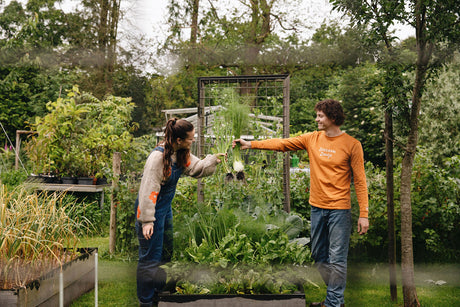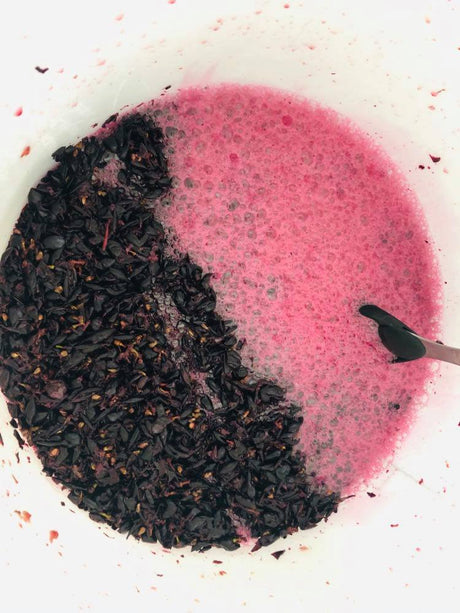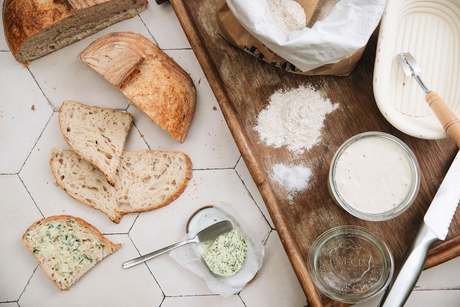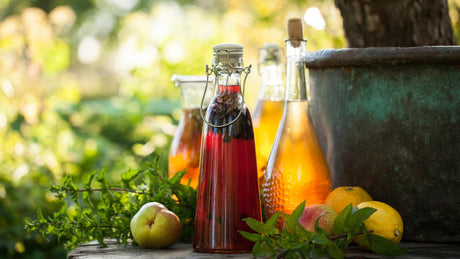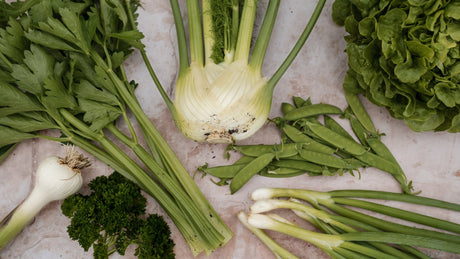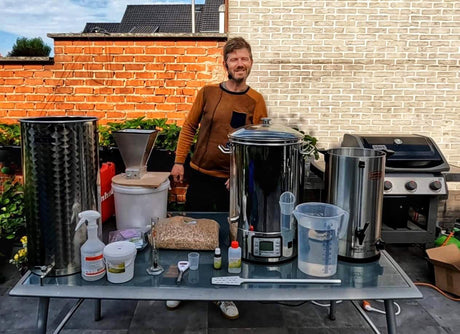Introduction
This article is about the most important thing about your vegetable garden, the vegetable garden soil and comes in 5 parts. Vicky Wilssens and I (Tom Deseyn) try to explain 'vegetable garden soil' in an easy way. Vicky and I are members of the Facebook Group Vegetable Garden and would like everyone to have a vegetable garden. In this way we contribute to nature and it is also just super fun to 'make' food. This article is written in easy text and builds from the basics and becomes more complete. We want 'everyone' to the vegetable garden. We are not scientists but friends of the vegetable garden who want to share information. Tips or advice are welcome via the contact form on the website. At the bottom of this article you can also say what you think of it. Here we go ... To grow healthy vegetables you need healthy soil. In a healthy vegetable garden soil your vegetables can eat and drink enough and they don't get sick. But what is in a good vegetable garden soil? Vegetable garden soil consists of 5 important components:- PART 1: Very small stone grains or minerals
- PART 2: Organic Matter and Humus
- PART 3: Water and air
- PART 4: Soil life
- PART 5: Plant Nutrients
PART 1: Tiny Stone Grains or Minerals in Your Vegetable Garden Soil
From rock to mineral
Your vegetable garden soil consists of almost half of stone grains, also called minerals. The very small stone grains come from stones and rocks. The reduction of rocks and stones to stone grains takes millions of years and is done by the wind, rain, ice, snow, sun, mosses, fungi and bacteria, ... The soil in your vegetable garden was once a stone or a rock ... millions of years ago.
(from stone to grain)
The size of the stone grains determines the type of soil in your vegetable garden soil
These rocks and stones have become smaller and are now pebbles, small stones or even smaller stone grains. In these smaller grains or minerals you can garden, in rocks or pebbles that is a bit more difficult, so we don't talk about that anymore.- Large grains (0.05 – 2 millimeters) are called sand
- Smaller grains (0.002 – 0.005 millimeters) are called silt
- Smallest grains (smaller than 0.002 millimeters) are called clay
 Sandy vegetable garden soil with traces of black humus
Sandy vegetable garden soil with traces of black humusVegetable garden soil or soil with many large grains or sandy soil:
Good points: Sandy soil is airy, the roots of your plants can grow well, grains of sand warm up well and sandy soil is easy to work. Think of a sand castle (easy to work) or walking on the sand with your bare feet when the sun is shining brightly (hot hot hot). Bad points: Sandy soil has a hard time holding water and nutrients. Pour a bucket of water on sandy soil in the vegetable garden and after half a minute the puddle will be gone.- Top vegetables for sandy soil: beans , peas , carrots and crops from southern countries.
- Flop vegetables for sandy soil: plants that need a lot of water.
Vegetable garden soil or soil with small grains or clay soil:
Good points: Clay soil does hold water and/or minerals. Think of modeling clay. That can also be very sticky. Vegetable gardens with clay soil are often difficult to work
Vegetable gardens with clay soil are often difficult to work- Top vegetables for clay soil: tubers (beetroot and celeriac ) and potatoes .
- Flop vegetables for clay soil: plants that do not like to have their feet in water (onions), carrots and plants that cannot tolerate frost.
Plant roots have very small mouths...
 Vegetable garden plants absorb nutrients through their roots, among other things.
Vegetable garden plants absorb nutrients through their roots, among other things.Little mouths can't handle big bites
Back to rocks and stones. Any type of rocks or stones can be reduced to sand, silt or clay. Your type of soil grains or minerals therefore actually depends on which rocks and stones were reduced millions of years ago. Now comes something very important ... Sand, silt and clay can consist of different minerals. Minerals are nutrients for people, plants and animals. The most common minerals in sand, silt or clay grains are: silicon, aluminium, iron, magnesium , calcium, sodium and potassium. But plants cannot eat rock grains or large pieces of minerals of course. Vegetables eat through their roots and they only have 'small mouths' on them. We can't eat a whole white cabbage or a whole cow either ... The minerals must therefore become very, very small before plants can absorb them. How do they get so small? Well, earlier we also talked about the wind, the rain, fungi and bacteria.Feed your vegetable garden soil with organic material
Rocks take millions of years to be completely broken down by bacteria/fungi into tiny mineral particles. But in our vegetable garden, vegetables are grown every year that need to grow quickly and therefore need a lot of food. Neither we nor our vegetables can wait millions of years for mineral particles to be 'released' from the rocks. Fortunately, worms, bacteria and fungi can also release mineral particles from much softer and easier material: twigs, leaves, ... in short, organic material. And fortunately we don't have to wait a million years for that. Very soft material such as comfrey leaves are already digested after 6 weeks and thus become plant food. Leaves of trees and small twigs take 1 to 2 years and tree trunks much longer. And we can also throw mineral-rich material on the vegetable garden soil that the worms, bacteria and fungi make small pieces of, until they are small enough to fit in the mouth of a plant root: grass, ...(fungi, bacteria and soil life)
Humus, the glue in our vegetable garden soil holds everything together
Up until now in this text everything is very easy. Stones and rocks become smaller, are small grains of stone or minerals and when they are small enough they can be eaten by plants. Easy right? Not so. There is a big danger. All the super small minerals that the plants can eat, are washed away by the rain when there are only grains of stone in our soil. We need a kind of glue that holds all the minerals big and small together. If we don't do that, then all our edible minerals will wash away in our vegetable garden. But we can't pour glue in our garden, can we? No, that's right, that wouldn't be a good idea. What do we need then? Exactly! organic material that becomes humus. Organic material is branches, leaves, dead animals in the vegetable garden soil, ... Just like the rocks and stones and the rocks from earlier, that organic material also reduces. First we have organic material, then we speak of compost (half digested) and finally humus (100% digested). We don't have to convert organic material into humus ourselves, fortunately. The conversion is done by fungi, bacteria and soil animals (especially worms). Humus is the glue we need to keep our vegetable garden soil together and also contains many other growth substances. More about this later in the following parts.
(a balanced vegetable garden soil)
Also read PART 1PART 2: Organic matter in your vegetable garden soil and ultimately: humus
In PART 1 of this article we saw how rocks were broken down by the weather into tiny grains of stone or minerals. This takes millions of years. If the minerals are small enough, plants can absorb them as food. In the vegetable garden we have two problems. We don't have millions of years and we want to grow a lot in a small space. I can hear you thinking: "We need extra minerals and nutrients..." So we need minerals that break down faster and don't take a million years to break down. But preferably just a few weeks or months. Every vegetable gardener already knows which way we're going. Indeed, what we need is 'organic material'. That's dead plants and dead animals. Of course, you shouldn't work dead chicken or steak into your soil. By dead animals we mean insects, worms, snail shells, ... These are full of minerals, just like dead plants. A very valuable fertilizer is made from these dead plants and animals: humus or 'black gold'. Partially decomposed organic material is called compost , fully decomposed organic material is called humus. The softer the material, the faster it will become humus. Comfrey leaf is already decomposed after 6 weeks. A twig takes a few months and a tree trunk years. In our garden we can throw organic material on the ground, that is called mulching. Another way is to let organic material next to our vegetable garden decompose into compost or humus . Let us look at the two ways:Mulching in the vegetable garden
Mulching involves applying a layer of 5 to 15 cm of organic material. This can be: grass, straw, wood chips, comfrey leaves, coffee grounds, ... The mulch layer is a jacket for your vegetable garden. The soil life in your soil is very fond of organic material. Worms, for example, come from the vegetable garden soil to the surface, eat your organic material and 'sh*t' humus into your soil, as it were. In every garden with organic material there are thousands of worms that do the work for you. They are the diggers and humus makers in your vegetable garden. There are two more very important advantages to mulching for our body. The mulch layer stops weeds. Germinating weed seeds do not get through the mulch layer, so we do not have to bend or go down on our knees to weed. Mulching with a mixture of wood chips and compost
Mulching with a mixture of wood chips and compost
compost and humus on and in your vegetable garden soil
You can also place or work in organic material that has already been digested ( compost or humus ). Making compost in your garden is quite easy ( http://www.velt.nu/composteren ). You can also buy ready-made compost in the store. An advantage of composting yourself is that you can determine the composition of your compost yourself. I alternate the following materials in different layers for a good balance: pruning waste up to 1 cm in diameter, chopped, green waste from the vegetable garden and the kitchen, coffee grounds, egg shells and fresh manure from my chickens and an acquaintance's horse. And digest, the digestion takes 4 to 8 months, depending on the season and the material you are composting . With compost you give your soil life a helping hand. The soil life gets ready-made organic material that is immediately available. When mulching, the soil life has to wait for the digestion process of your mulch layer. An additional advantage of compost or humus is that you can give your soil structure a boost. A pure sandy soil or a hard clay soil will not get a good structure as quickly with mulching as with compost or humus. If you have a new vegetable garden and it is a sandbox or clay block, consider compost or humus first. If you already have a good airy structure, choose mulching but you can also combine both. The gifts 'no weeds' and 'less watering' are of great value with mulching. Soil life in the vegetable garden is crucial for success
Soil life in the vegetable garden is crucial for successVegetable garden soil life
Finally. Humus is an important fertilizer for plants and fortunately also contains minerals. It doesn't take a million years to get these minerals into your vegetable garden. In a few weeks or months, the minerals that were in the dead plants and animals have become humus. Isn't that great? And it gets even better: humus doesn't just contain minerals. It is, as mentioned in PART 1, the glue of your vegetable garden soil. Humus will also ensure that minerals don't wash away from your rock grains that we talked about in PART 1. Humus is a bit like a sticky sponge where minerals (and also water!) stick until the plants are hungry and eat them. Who or what breaks down these dead animals and plants (organic material)? We called it 'soil life' above, this will also be discussed later in this series of articles about vegetable garden soil. By this we mean fungi in the soil, bacteria, worms and other small animals. They break down this organic material by eating it. The nice thing is that fungi, bacteria, worms and other creatures work together. Sometimes the soil animals cannot eat something at first because it is still too big or too hard, think of a branch. In that case, soil fungi will first do their work until the branch pulverizes. If the branch is then small and soft enough, the soil animals can eat it. When this is completely digested, it consists of such small particles that it can be absorbed by your plants: humus. This humus has therefore become a kind of fertilizer for your plants. And it is such a valuable fertilizer that it is also called 'black gold'. Fungi and bacteria are the cooks, the animals eat it with pleasure and the residual product is worm poop (and also from other creatures). It feels crumbly to us and it smells wonderfully of forest soil! A healthy humus rich vegetable garden soil
A healthy humus rich vegetable garden soil- is a black type of sponge that contains minerals and water and retains it until the plant needs it
- is made by soil animals and consists of, among other things, 'worm poop',
- is formed by the decomposition of dead plants and animals (organic material),
- smells nice of forest floor,
- is so valuable as a fertilizer for your plants that it is also called 'black gold'.
PART 3: Water and air in your vegetable garden soil
Also read PART 1 and 2Repetition of minerals and humus
We already know that soil consists of almost half of stone grains: sand grains, silt grains or clay grains. We also know that some of these stone grains have become very crumbly and small. As a result, they can be absorbed by the small mouths of the plant roots. But… because they are so small, they also wash away very easily. Fortunately, (healthy) soil contains a 'safety net' that catches and holds these small minerals so that they do not wash away. This 'safety net' looks like a sponge, is black, smells like forest soil and is also called 'humus'. Because it is so valuable, gardeners also call it 'black gold'. So: in soil there are rock grains and humus. That is not enough to have a fertile soil. What is still missing? Air and water!
So: in soil there are rock grains and humus. That is not enough to have a fertile soil. What is still missing? Air and water!
Water for your vegetable garden plants
Water ensures that the plants have something to drink. Water also transports the small minerals through the soil. In this way, minerals flow to the plant, which, thanks to the water, drinks a 'healthy drink with minerals'. However, if the water flows too heavily (in heavy rain), it can happen that the minerals are washed away too quickly and that only plain water remains for the plant. If you have a good humus layer in your vegetable garden soil at such times, there is no problem because the minerals will stick to the 'safety net'. Water is not only there for the plants but also for the small soil animals that make the humus! The water between the stone grains will also ensure that the air is pushed away and that new air (and therefore new oxygen) takes its place. Below you can read why this is so important.
So, to summarize: water…
Water is not only there for the plants but also for the small soil animals that make the humus! The water between the stone grains will also ensure that the air is pushed away and that new air (and therefore new oxygen) takes its place. Below you can read why this is so important.
So, to summarize: water…
- Is drinking for the plants
- Is drinking for the soil creatures
- Contains nutritious minerals
- Transports nutritious minerals through the vegetable garden soil (but sometimes too quickly and then they wash away)
- Ensures that new air and oxygen are drawn in from time to time
Air in your vegetable garden soil
Do plants need air underground? No, plants do not need air but soil animals do! The soil animals that make humus and even protect your plant roots from bad guys die if there is not enough oxygen underground. Without oxygen, the good soil animals die and bad soil animals take their place that can live without oxygen, a bit like 'zombies'. It is therefore important that there is always enough oxygen in the soil. Air also ensures that there is space between the stone grains, for example space for water, but also space for small animals. In summary, air ...- Contains oxygen for the beneficial soil animals
- Provides space for water or small animals between the stone grains
Water and air in balance
And how do you make sure that there is enough air and water in your vegetable garden soil? Do you have to 'pour air' over your plants with a watering can ? No, of course not. You have to make sure that your soil contains both large stone grains (sand) and smaller stone grains (silt and clay). A good portion of humus also retains the water. If there is (too) much room for air between the large stone grains, the water seeps away. If there is (too) little room for air between the small stone grains, the water cannot pass through. By providing a mixture of large and small grains, you will achieve a perfect balance of air and water in your soil. abovePART 4: Soil life in your vegetable garden soil
Also read PART 1, 2 and 3Introduction
Let me briefly reiterate what we already know, soil consists mainly of- Very finely ground pebbles: grains of sand, silt grains and/or clay grains.
- Minerals, derived from:
- stone grains that are ground very finely
- dead organic material such as twigs, leaves, insects, etc. that has turned into humus.
- Air and water
- Soil life that makes humus and performs other wonders.
Soil life is ...
We already talked about soil life in the previous parts. But what is soil life? Well, soil life consists of a hodgepodge of snails, worms, beetles, spiders, flies, nematodes, fungi and unicellular organisms such as bacteria, archae, algae, slime molds and protozoa. Each animal or organism helps a little to make humus. Large animals or large organisms take the large parts of 'organic material' for themselves such as thick branches or leaves. When they have eaten this and excreted or broken it, the large pieces are already somewhat smaller and smaller animals can eat it and excrete it. In this way, the large pieces of branches or leaves or ... become smaller and softer. What remains is ultimately a soft crumbly black mass: humus.
Superpowers underground
Soil life does a lot of work and many wonders. If we as humans wanted to imitate that, it would cost us a lot of time, energy and money. Below you can see what wonders your soil life performs:-
They clean up waste:
- Dead branches, leaves, bugs, vegetable waste, … are broken down until they become humus. So you don't have to clean it up yourself. Leave it as mulch and the soil life makes humus/fertilizer from it.
- Even trees or tree branches can be cleared! Soil fungi make fungal threads in dead wood. If the fungus has grown well in the wood, mushrooms sometimes appear. These mushrooms are the fruiting bodies of the fungus, a bit like an apple is a fruit of the apple tree. The fungus feeds on the dead wood and after a while the wood becomes soft and rotten, so soft that it falls apart. The soft mass that you then have is not yet humus, but it is already a step closer to humus. Other animals can eat this mass. When they excrete it, we are another step closer to humus.

-
They make your soil more fertile.
- The minerals that are in the belly of a creature cannot be washed away! This keeps minerals safely stored until the creature excretes them.
- And when the animal excretes this, the mineral sticks in the uh ... manure so that it also does not wash away and remains available for the plants. So they fertilize your soil with their excrement. !! Notice it says 'THEY' fertilize and not 'YOU' fertilize!! If your soil life is healthy and gets plenty of food (mulch), it will constantly and gradually fertilize your soil itself and you don't have to do that by buying fertilizer.)
- Soil that has been through a worm contains 7 times more absorbable phosphate, 10 times more absorbable potassium, 5 times more absorbable nitrogen, 3 times more absorbable magnesium and one and a half times more absorbable calcium!
- Soil that has been passed through a worm has become more neutral in acidity and has therefore become better soil. This makes it easier for plant mouths to absorb minerals.
- They provide the right form of nitrogen for your plants. We have heard of nitrogen as a fertilizer. Animal manure contains nitrogen and chemical fertilizers contain nitrogen. (The 'N' in NPK refers to nitrogen.) The air also contains nitrogen. It is not the same for a plant in which form it receives nitrogen. (Compare it a bit with picky people and potatoes : some prefer to eat boiled




